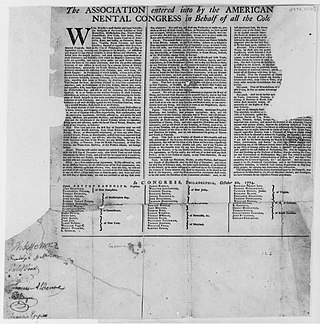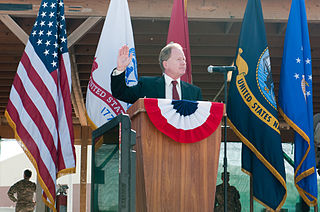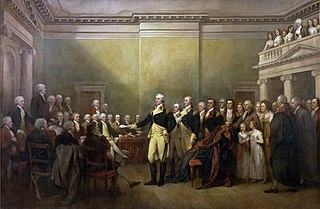Related Research Articles

The Declaration of Independence, formally titled The unanimous Declaration of the thirteen united States of America, is the founding document of the United States. On July 4, 1776, it was adopted unanimously by the 56 delegates to the Second Continental Congress, who had convened at the Pennsylvania State House, later renamed Independence Hall, in the colonial era capital of Philadelphia. The declaration explains to the world why the Thirteen Colonies regarded themselves as independent sovereign states no longer subject to British colonial rule.
The Irish Oath of Allegiance was a controversial provision in the Anglo-Irish Treaty of 1921, which Irish TDs and Senators were required to swear before taking their seats in Dáil Éireann and Seanad Éireann before the Constitution Act 1933 was passed on 3 May 1933. The controversy surrounding the Oath was one of the principal issues that led to the Irish Civil War of 1922–23 between supporters and opponents of the Treaty.
All officers of the eight uniformed services of the United States swear or affirm an oath of office upon commissioning. It differs from that of the oath of enlistment that enlisted members recite when they enter the service. It is required by statute, the oath being prescribed by Section 3331, Title 5, United States Code. It is traditional for officers to recite the oath upon promotion but as long as the officer's service is continuous this is not required.

Richard Stockton was an American Founding Father, lawyer, jurist, legislator, and signer of the Declaration of Independence.

Charles Carroll, known as Charles Carroll of Carrollton or Charles Carroll III, was an American politician, planter, and signatory of the Declaration of Independence. He was the only Catholic signatory of the Declaration and the longest surviving, dying 56 years after its signing.

The Second Continental Congress was the late-18th-century meeting of delegates from the Thirteen Colonies that united in support of the American Revolution and its associated Revolutionary War, which established American independence from the British Empire. The Congress created a new country that it first named the United Colonies, and in 1776, renamed the United States of America. The Congress began convening in Philadelphia, on May 10, 1775, with representatives from 12 of the 13 colonies, after the Battles of Lexington and Concord.

The Sons of Liberty was a loosely organized, clandestine, sometimes violent, political organization active in the Thirteen American Colonies founded to advance the rights of the colonists and to fight taxation by the British government. It played a major role in most colonies in battling the Stamp Act in 1765 and throughout the entire period of the American Revolution.
Edward Biddle (1738–1779) was an American soldier, lawyer, and statesman from Pennsylvania. He was a delegate to the Continental Congress in 1774 and 1775 and a signatory to the Continental Association, which was drafted and adopted by that Congress.

The Continental Association, also known as the Articles of Association or simply the Association, was an agreement among the American colonies adopted by the First Continental Congress in Philadelphia on October 20, 1774. It was a result of the escalating American Revolution and called for a trade boycott against British merchants by the colonies. Congress hoped that placing economic sanctions on British imports and exports would pressure Parliament into addressing the colonies' grievances, especially repealing the Intolerable Acts, which were strongly opposed by the colonies.
An oath of citizenship is an oath taken by immigrants that officially naturalizes immigrants into citizens. It is often the final step in this process, and is usually done in a ceremonial capacity. An oath of citizenship is designed to be a statement of patriotism and loyalty to the new country. In countries which retain a monarchical system of government, an oath of allegiance to the monarch is often required as well. Adding an oath to God to the end of an oath is usually optional.

The Oath of Allegiance of the United States is the official oath of allegiance that must be taken and subscribed by every immigrant who wishes to become a United States citizen.

The Committee of Secret Correspondence was a committee formed by the Second Continental Congress and active from 1775 to 1776. The Committee played a large role in attracting French aid and alliance during the American Revolution. In 1777, the Committee of Secret Correspondence was renamed the Committee of Foreign Affairs.

Pennsylvania was the site of many key events associated with the American Revolution and American Revolutionary War. The city of Philadelphia, then capital of the Thirteen Colonies and the largest city in the colonies, was a gathering place for the Founding Fathers who discussed, debated, developed, and ultimately implemented many of the acts, including signing the Declaration of Independence, that inspired and launched the revolution and the quest for independence from the British Empire.
Near the end of the American Civil War, the Ironclad Oath was an oath promoted by Radical Republicans that required federal employees, lawyers, and federal elected officials to swear upon entry of office that they had never supported the Confederacy. The first such law adopted by Congress was in 1862 which attempted to make the oath a requirement for the incoming members of the 38th United States Congress to take the oath. In 1863, President Abraham Lincoln proposed the Ten percent plan, which proposed that a state in rebellion could be reintegrated if a similar oath, with an additional pledge to abide by the nationwide abolition of slavery, was taken by 10% of its voters. Congress then attempted to raise this to 51% of voters in the Wade–Davis Bill of 1864, which Lincoln pocket vetoed on the grounds that it was too harsh. After the assassination of Lincoln in 1865, his successor, Andrew Johnson, opposed the oath altogether. Given the temporary disenfranchisement of the numerous Confederate veterans and local civic leaders, a new Republican biracial coalition came to power in the eleven Southern states during Reconstruction. Southern conservative Democrats were angered to have been disenfranchised.

William Paca was a Founding Father of the United States who was a signatory to the Continental Association and the United States Declaration of Independence. He was a Maryland delegate to the First Continental Congress and the Second Continental Congress, governor of Maryland, and a district judge of the United States District Court for the District of Maryland.

Then Province of Maryland had been a British / English colony since 1632, when Sir George Calvert, first Baron of Baltimore and Lord Baltimore (1579-1632), received a charter and grant from King Charles I of England and first created a haven for English Roman Catholics in the New World, with his son, Cecilius Calvert (1605-1675), the second Lord Baltimore equipping and sending over the first colonists to the Chesapeake Bay region in March 1634. The first signs of rebellion against the mother country occurred in 1765, when the tax collector Zachariah Hood was injured while landing at the second provincial capital of Annapolis docks, arguably the first violent resistance to British taxation in the colonies. After a decade of bitter argument and internal discord, Maryland declared itself a sovereign state in 1776. The province was one of the Thirteen Colonies of British America to declare independence from Great Britain and joined the others in signing a collective Declaration of Independence that summer in the Second Continental Congress in nearby Philadelphia. Samuel Chase, William Paca, Thomas Stone, and Charles Carroll of Carrollton signed on Maryland's behalf.
The Oath of Allegiance is an oath administered to and recited by immigrants who wish to accede to the citizenship of the Republic of the Philippines. The current oath, based on the United States Oath of Allegiance, was first enshrined in Commonwealth Act No. 473, the Revised Naturalization Law of 1939, with the modern version enshrined in Republic Act No. 9225, the Citizenship Retention and Re-acquisition Act of 2003.

The Plantation Act 1740 or the Naturalization Act 1740 are common names used for an act of the British Parliament that was officially titled An Act for Naturalizing such foreign Protestants and others therein mentioned, as are settled or shall settle in any of His Majesty's Colonies in America.
The Augusta Declaration, or the Memorial of Augusta County Committee, May 10, 1776, was a statement presented to the Fifth Virginia Convention in Williamsburg, Virginia on May 10, 1776. The Declaration announced the necessity of the Thirteen Colonies to form a permanent and independent union of states and national government separate from Great Britain, with whom the Colonies were at war.

The Confederate oath of allegiance, an oath of allegiance to the Confederate States of America, was taken by officers and enlisted men of the CSA (1861–1865) during the American Civil War. In contrast to the American oath of allegiance, Confederates swore "allegiance to the Confederate States without mention of allegiance to their constitution." Confederate oaths varied somewhat by state, and in the spirit of the CSA's proclaimed preference for states' rights over a unified federal government with majority rule and minority rights, Confederate oaths were often made to specific state governments.
References
- 1 2 "American Revolution | Causes, Battles, Aftermath, & Facts | Britannica". www.britannica.com. 2024-01-03. Retrieved 2024-01-10.
- 1 2 3 4 5 6 7 8 9 10 11 12 13 14 15 16 17 18 19 20 21 22 Sinks, D. John. https://dcssar.org/resources/Documents/Publications/1778%20Oaths%20_%20Enumeration%20DC%20Vsn.pdf. 2023-05-12. Retrieved 2024-01-10.
- ↑ John Thomas Scharf, History of Maryland from the Earliest Period to the Present Day . Published by J. B. Piet, 1879
- ↑ Carothers, Bettie S.; Maryland Oaths of Fidelity; ISBN 1-58549-401-1
- 1 2 3 "Oath of Fidelity and Support". www.angelfire.com. Retrieved 2024-01-10.
- ↑ Daughters of the American Revolution Magazine, Daughters of the American Revolution, Published by R.R. Bowker Co., 1916 v.50 1917 Jan-Jun
- ↑ 9,000 Men Who Signed the Oath of Allegiance and Fidelity to Maryland During the Revolution, Vol. 1 (Eastern Shore), Bettie Stirling Carothers, Lutherville, Maryland
- ↑ "Maryland State Archives - Guide to Government Records". guide.msa.maryland.gov. Retrieved 2023-05-23.
- 1 2 Sinks, John D. (8 May 2021). "Oaths of Allegiance During the American Revolution" (PDF). District of Columbia Society, Sons of the American Revolution.
- ↑ https://www.dcssar.org/resources/Documents/Publications/Oaths%20of%20Allegiance%20During%20the%20American%20Revolution%208%20May%202021.pdf